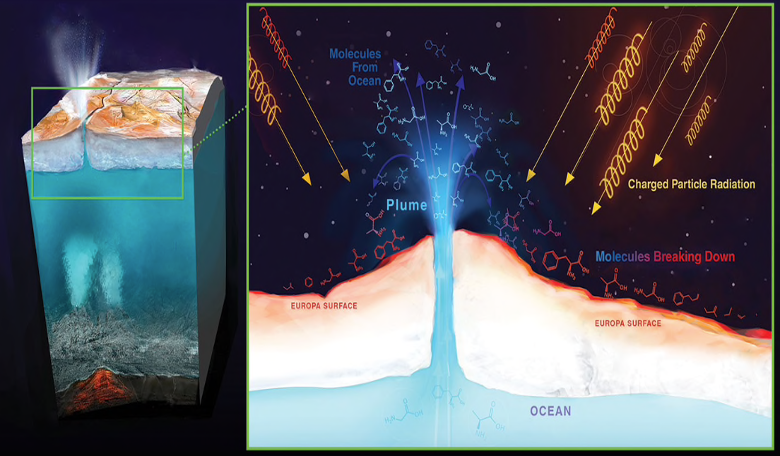With harsh radiation constantly pouring down on Europa, when NASA’s Europa Clipper or ESA’s JUICE mission heads to the small Jovian icy moon in a few years, would their instruments be able to detect signs of life on its surface or will a lander have to dig deep to find any conclusive evidence?
Since the 1990s when NASA's Galileo mission provided strong evidence of a global, possibly salty ocean hiding beneath Europa's icy shell, plans to visit the ice world to search for life were pushed to the forefront.
And when water-vapour plumes shooting out from the bottom of canyons on the moon’s south pole were discovered by the Cassini spacecraft in 2005, space agencies around the world were quick to start preparing for a future visit to the smallest of the four Galilean moons orbiting Jupiter, as the prospect of sampling the ocean without drilling through kilometres of thick ice became an even more tantalising idea.
So far, so good then. However there is one overriding aspect that any mission heading to the moon will have to overcome if it wants to succeed at spotting signs of life – dealing with the continued bombardment of charged particle radiation emanating from Jupiter’s magnetosphere; an attribute that has the potential to alter or decimate any potential biosignatures on Europa’s surface.
Seeking to find the best places to look is a team from NASA's Jet Propulsion Laboratory, California, led by Tom Nordheim, who have calculated the global bombardment pattern of energetic electrons hitting Europa’s surface using data from Galileo's flybys of Europa two decades ago and electron measurements from NASA's Voyager 1 spacecraft.
"If we want to understand what's going on at the surface of Europa and how that links to the ocean underneath, we need to understand the radiation," Nordheim said. "When we examine materials that have come up from the subsurface, what are we looking at? Does this tell us what is in the ocean, or is this what happened to the materials after they have been radiated?"
Their results show that radiation doses vary by location and that the harshest radiation is concentrated in zones around the equator. Conversely, closer to the poles, the radiation is not as intense.
"This is the first prediction of radiation levels at each point on Europa's surface and is important information for future Europa missions," said Chris Paranicas, a co-author from the Johns Hopkins Applied Physics Laboratory in Laurel, Maryland.
Now that the radiation hot spots have been mapped out, how deep would a future Europa lander mission need to dig or drill to find any biosignatures that might be preserved in the ice?
Perhaps not as deep as you might imagine. By using previously published information on amino acids that had been zapped with a beam of high-energy particles to see how they reacted, the team found that a lander would only have to dig down 10 to 20 centimetres (4 to 8 inches) in the highest-radiation zones and to less than 1 centimetre (0.4 inches) at middle- and high-latitudes, I.e towards Europa’s poles.
Although amino acids are not strictly a sign of life, they are the building blocks for proteins and they also serve as a useful example of molecular survival in high radiation environments.
"The radiation that bombards Europa's surface leaves a fingerprint," said Kevin Hand, co-author of the new research and project scientist for the potential Europa Lander mission. "If we know what that fingerprint looks like, we can better understand the nature of any organics and possible biosignatures that might be detected with future missions, be they spacecraft that fly by or land on Europa.”
With this information, Europa Clipper's mission team are now looking at routes that pass over many regions of Europa that have not been subjected to high levels of radiation. “That's good news for looking at potentially fresh ocean material that has not been heavily modified by the fingerprint of radiation,” said Hand.











